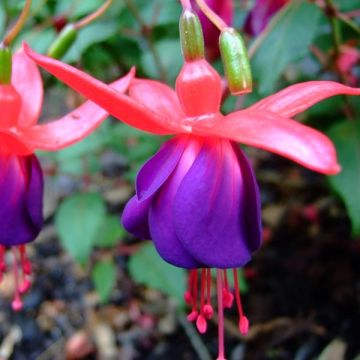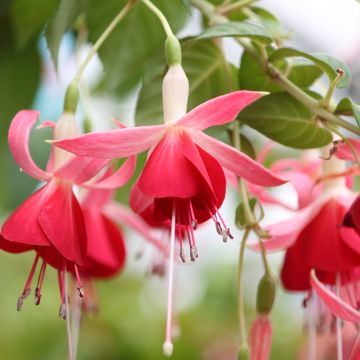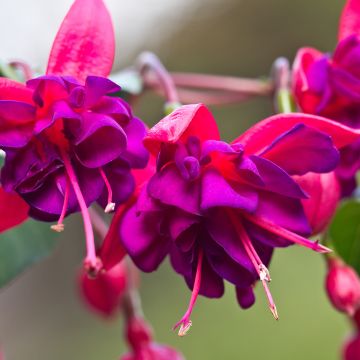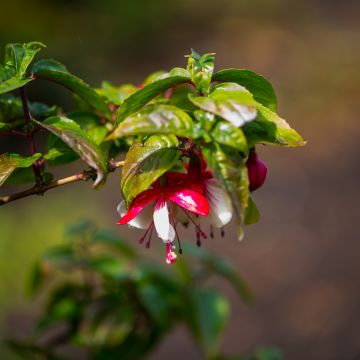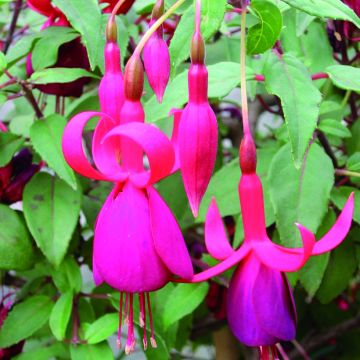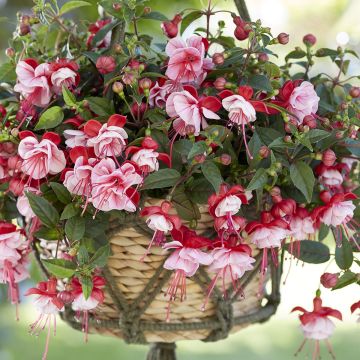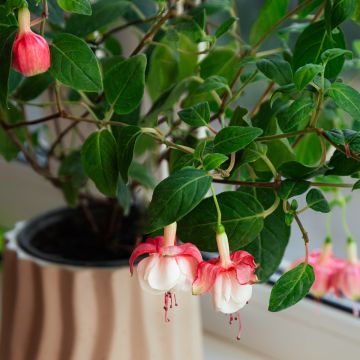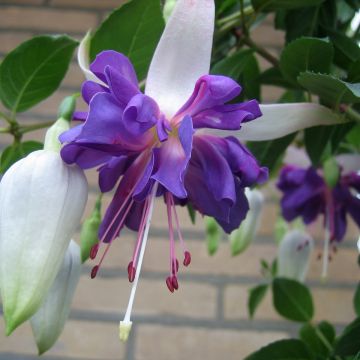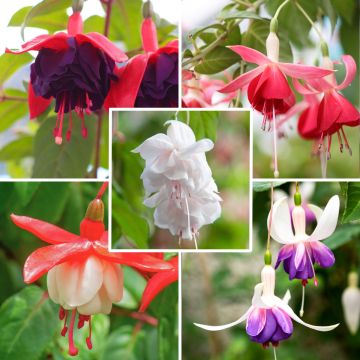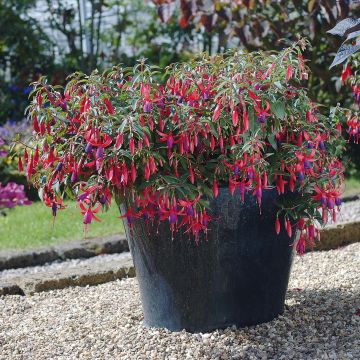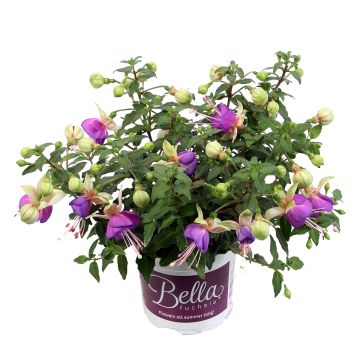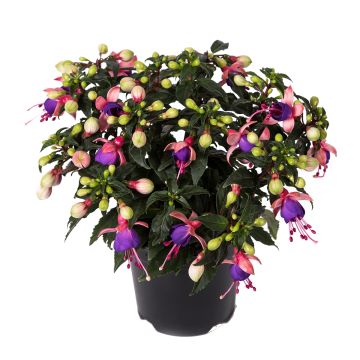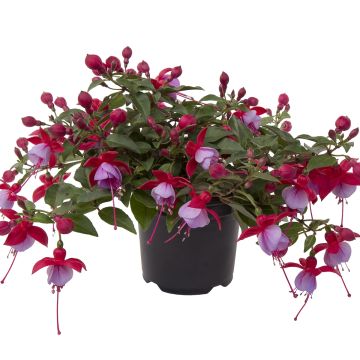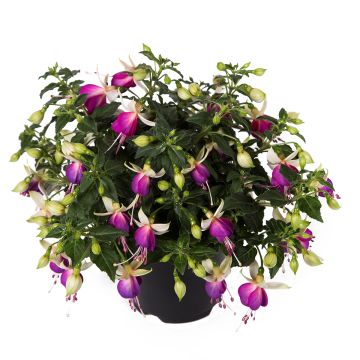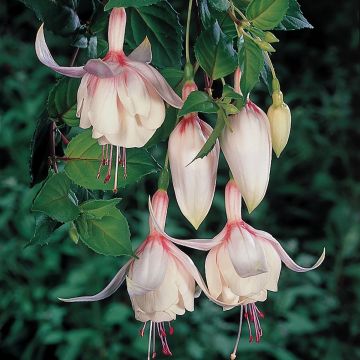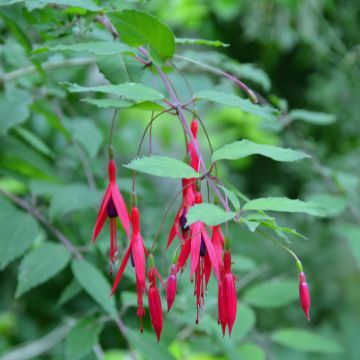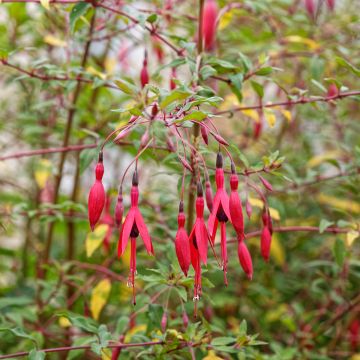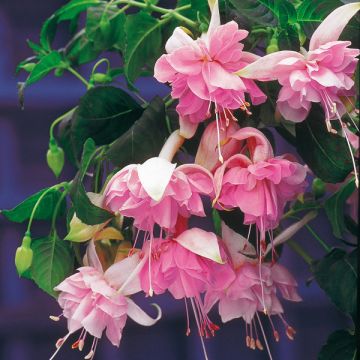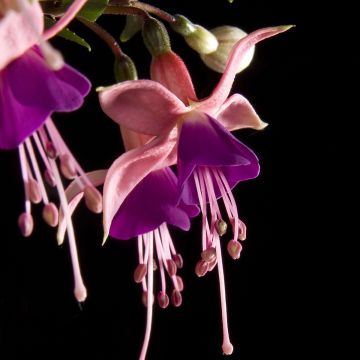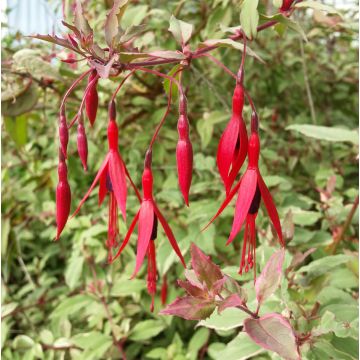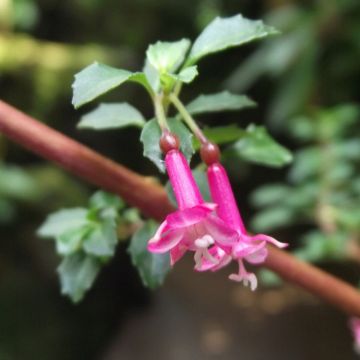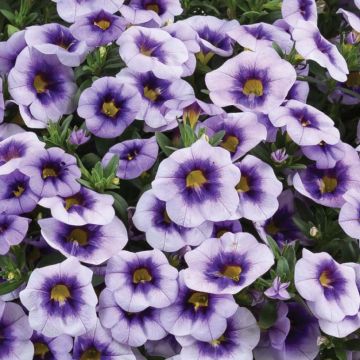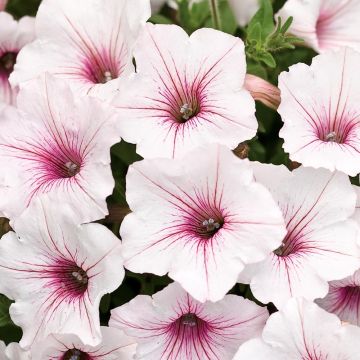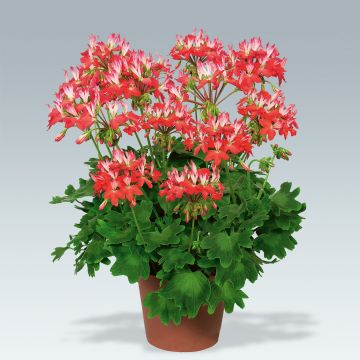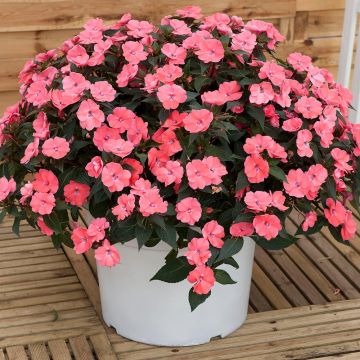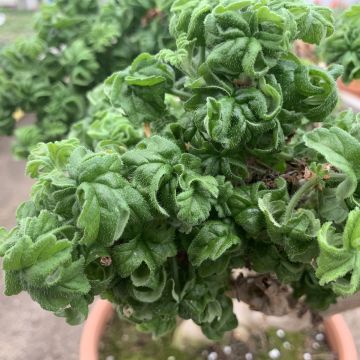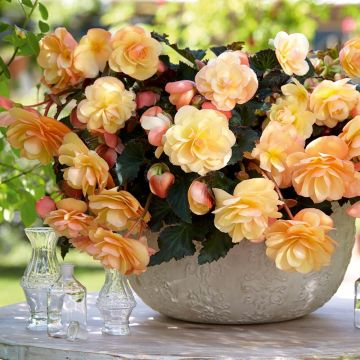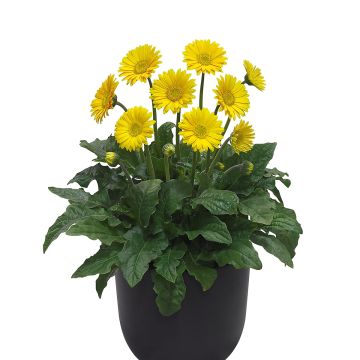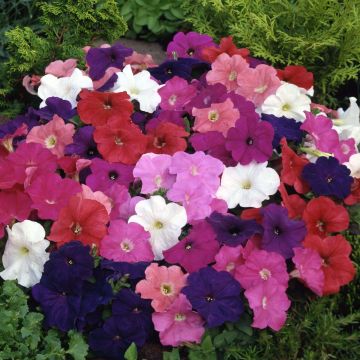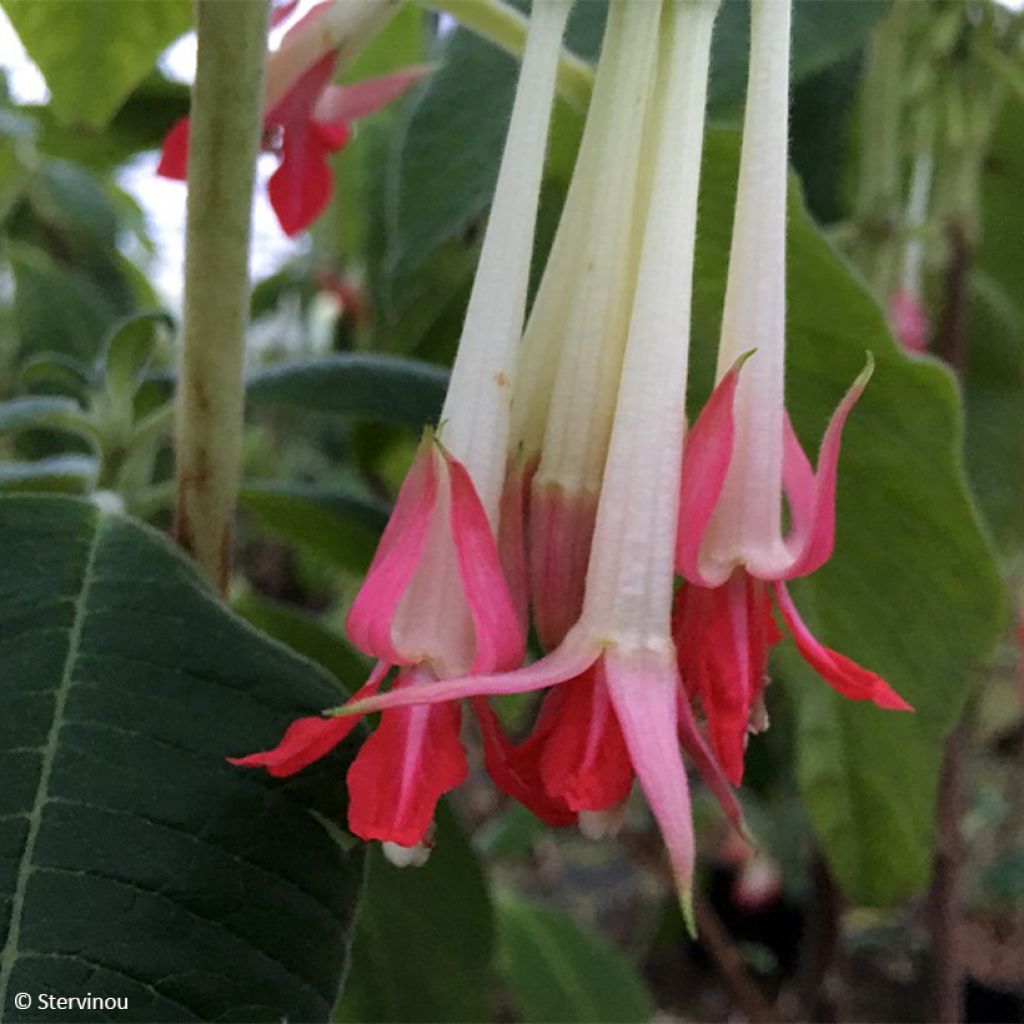

Fuchsia boliviana Alba
Fuchsia boliviana Alba
Fuchsia boliviana Alba
Bolivian Fuchsia, Bolivian Begonia
Why not try an alternative variety in stock?
View all →This plant carries a 24 months recovery warranty
More information
We guarantee the quality of our plants for a full growing cycle, and will replace at our expense any plant that fails to recover under normal climatic and planting conditions.
From €5.90 for pickup delivery and €6.90 for home delivery
Express home delivery from €8.90.
Does this plant fit my garden?
Set up your Plantfit profile →
Description
Fuchsia boliviana'Alba' is a very beautiful form of the Bolivian Fuchsia with very long white flowers with red corollas. It forms an erect bush, with few branches, flexible stems, and large leaves, sought after for its original, abundant, and prolonged flowering, from summer to autumn. In a greenhouse, it can still bloom in the middle of winter. Grow it in a large pot, in a semi-shaded position, in humus-bearing and moist soil. It can spend the summer outside and be overwintered frost-free.
Fuchsia boliviana is a botanical species native to South America, particularly Bolivia, southern Peru, and northern Argentina. It is a plant of hot and humid climates in summer, drier in winter. Like other Fuchsias, it belongs to the onagraceae family. The 'Alba' form is even rarer in cultivation and is distinguished by flowers with white tubes and sepals. It is a slightly spreading bush with flexible stems that can reach between 2.50 m and 4 m high in the ground under optimal conditions. In our climates, when grown in a large pot, it will reach about 1.50 m high and 1 m wide. Its foliage will fall with the frost but its crown can withstand some light frosts down to -4 °C in well-drained soil. The large, bright green, elliptical to lance-shaped leaves measure between 10 and 20 cm long. They are arranged alternately on the branches, occasionally opposite and are finely toothed. Flowering begins between late spring and early summer, or even late summer depending on the climate. It continues as long as the temperature remains mild. The tubular flowers measure 8 to 12 cm long and are grouped in pendulous clusters up to 20 cm long. Each flower consists of a long tube extended by 4 white sepals releasing a small scarlet red corolla with curled petals. After pollination by insects, elongated berries form, turning black when ripe. They are edible, with a texture somewhat like a kiwi.
Fuchsia boliviana 'Alba' will delight collectors and enthusiasts of rare plants. Outside the mildest areas, it must be grown in a pot. You can place it prominently on the terrace, elevating it slightly to admire its incredible flowering up close. Choose a partially shaded spot, as it dislikes intense sunlight. To compliment it, arrange some pots of dwarf hostas and discreet creeping plants such as variegated ground ivy Glechoma hederacea 'Variegata'. Bring it indoors to a temperate greenhouse or conservatory in autumn, before the first frost.
Report an error about the product description
Plant habit
Flowering
Foliage
Botanical data
Fuchsia
boliviana
Alba
Onagraceae
Bolivian Fuchsia, Bolivian Begonia
South America
Other Fuchsia
Planting and care
The 'Alba' Bolivian Fuchsia will be happy in partial shade in moist, fertile, slightly acidic, light and well-drained soil, retaining moisture in summer. It does not appreciate scorching sun or soils which are very wet in winter. Morning sun is well tolerated.
Its leaves fall as soon as it freezes and its stems perish below -2°C. The crown can survive short frosts of around -4°C, if well protected by mulch.
It must be grown in a large pot (30 litres) with drainage holes at the bottom in most regions. Use good quality horticultural soil and create a drainage bed (clay balls) at the bottom of the pot. Water regularly from spring to autumn and reduce watering a little in winter. Annual pruning after flowering stimulates growth and promotes flowering the following year. The pot should be overwintered between 8 and 15°C in a bright room. Like all plants in a temperate greenhouse or orangery, this fuchsia is susceptible to whiteflies, aphids, and red spider mite.
Planting period
Intended location
Care
This item has not been reviewed yet - be the first to leave a review about it.
Plug plants - Annuals
Haven't found what you were looking for?
Hardiness is the lowest winter temperature a plant can endure without suffering serious damage or even dying. However, hardiness is affected by location (a sheltered area, such as a patio), protection (winter cover) and soil type (hardiness is improved by well-drained soil).

Photo Sharing Terms & Conditions
In order to encourage gardeners to interact and share their experiences, Promesse de fleurs offers various media enabling content to be uploaded onto its Site - in particular via the ‘Photo sharing’ module.
The User agrees to refrain from:
- Posting any content that is illegal, prejudicial, insulting, racist, inciteful to hatred, revisionist, contrary to public decency, that infringes on privacy or on the privacy rights of third parties, in particular the publicity rights of persons and goods, intellectual property rights, or the right to privacy.
- Submitting content on behalf of a third party;
- Impersonate the identity of a third party and/or publish any personal information about a third party;
In general, the User undertakes to refrain from any unethical behaviour.
All Content (in particular text, comments, files, images, photos, videos, creative works, etc.), which may be subject to property or intellectual property rights, image or other private rights, shall remain the property of the User, subject to the limited rights granted by the terms of the licence granted by Promesse de fleurs as stated below. Users are at liberty to publish or not to publish such Content on the Site, notably via the ‘Photo Sharing’ facility, and accept that this Content shall be made public and freely accessible, notably on the Internet.
Users further acknowledge, undertake to have ,and guarantee that they hold all necessary rights and permissions to publish such material on the Site, in particular with regard to the legislation in force pertaining to any privacy, property, intellectual property, image, or contractual rights, or rights of any other nature. By publishing such Content on the Site, Users acknowledge accepting full liability as publishers of the Content within the meaning of the law, and grant Promesse de fleurs, free of charge, an inclusive, worldwide licence for the said Content for the entire duration of its publication, including all reproduction, representation, up/downloading, displaying, performing, transmission, and storage rights.
Users also grant permission for their name to be linked to the Content and accept that this link may not always be made available.
By engaging in posting material, Users consent to their Content becoming automatically accessible on the Internet, in particular on other sites and/or blogs and/or web pages of the Promesse de fleurs site, including in particular social pages and the Promesse de fleurs catalogue.
Users may secure the removal of entrusted content free of charge by issuing a simple request via our contact form.
The flowering period indicated on our website applies to countries and regions located in USDA zone 8 (France, the United Kingdom, Ireland, the Netherlands, etc.)
It will vary according to where you live:
- In zones 9 to 10 (Italy, Spain, Greece, etc.), flowering will occur about 2 to 4 weeks earlier.
- In zones 6 to 7 (Germany, Poland, Slovenia, and lower mountainous regions), flowering will be delayed by 2 to 3 weeks.
- In zone 5 (Central Europe, Scandinavia), blooming will be delayed by 3 to 5 weeks.
In temperate climates, pruning of spring-flowering shrubs (forsythia, spireas, etc.) should be done just after flowering.
Pruning of summer-flowering shrubs (Indian Lilac, Perovskia, etc.) can be done in winter or spring.
In cold regions as well as with frost-sensitive plants, avoid pruning too early when severe frosts may still occur.
The planting period indicated on our website applies to countries and regions located in USDA zone 8 (France, United Kingdom, Ireland, Netherlands).
It will vary according to where you live:
- In Mediterranean zones (Marseille, Madrid, Milan, etc.), autumn and winter are the best planting periods.
- In continental zones (Strasbourg, Munich, Vienna, etc.), delay planting by 2 to 3 weeks in spring and bring it forward by 2 to 4 weeks in autumn.
- In mountainous regions (the Alps, Pyrenees, Carpathians, etc.), it is best to plant in late spring (May-June) or late summer (August-September).
The harvesting period indicated on our website applies to countries and regions in USDA zone 8 (France, England, Ireland, the Netherlands).
In colder areas (Scandinavia, Poland, Austria...) fruit and vegetable harvests are likely to be delayed by 3-4 weeks.
In warmer areas (Italy, Spain, Greece, etc.), harvesting will probably take place earlier, depending on weather conditions.
The sowing periods indicated on our website apply to countries and regions within USDA Zone 8 (France, UK, Ireland, Netherlands).
In colder areas (Scandinavia, Poland, Austria...), delay any outdoor sowing by 3-4 weeks, or sow under glass.
In warmer climes (Italy, Spain, Greece, etc.), bring outdoor sowing forward by a few weeks.

































